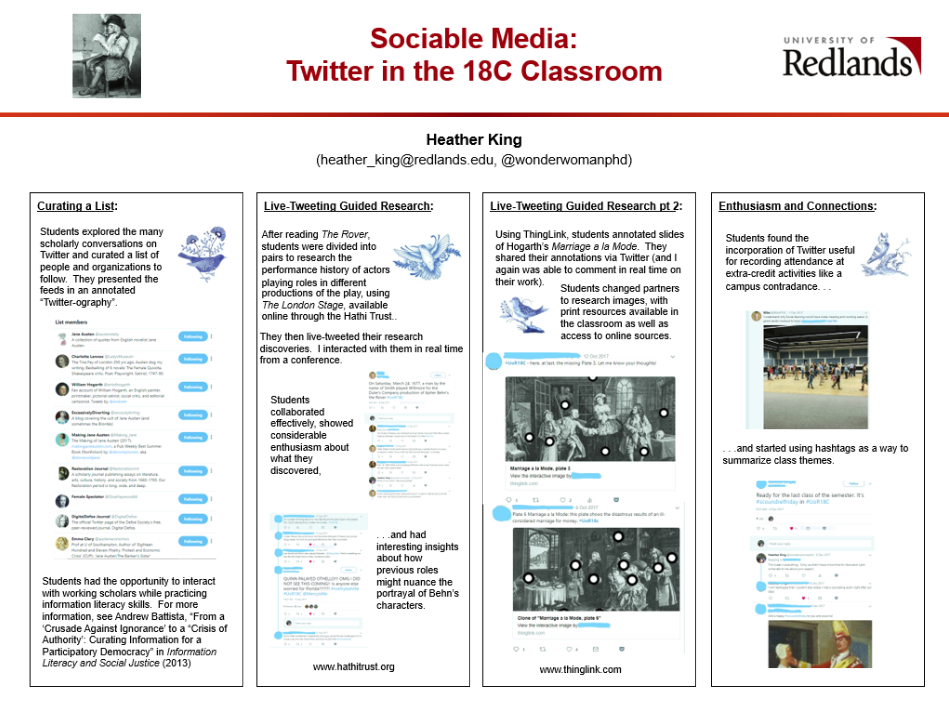Heather King | Social Media using Twitter

Case Study in Brief
Course: ENG English 209: Fairy Tales, English 322: Eighteenth Century Literature, English 208: Young Adult Fiction and English 218: Graphic Novels
Instructor: Dr. Heather King
Semester: Multiple
May 17', Fall 17', Spring 18', and May 18'
Number of Students: Total 84
Instructional Designer/Consult: Cheyne Murray
Purpose
"When I attended the annual meeting for my primary disciplinary conference, the American Society for Eighteenth-Century Studies, in March 2016, I was surprised to learn how many academic conversations were taking place on Twitter, a platform I had not yet explored. Ranging from announcements about conferences, publications, etc, to long threads about important topics, to educational posts of the “on this day in history” variety, I was excited to see how much was out there. In the same spring, I attended the Y’all West Young Adult Literature Convention, and heard repeatedly from authors and editors that aspiring writers, teachers, fans, etc, could (and should) contact them on Twitter or through their web pages. I started following a couple of authors I liked and a couple of professional organizations, and felt like I was in a conversation that I hadn’t had access to in quite the same way before. Since we routinely tell students that their papers should be entries into a larger academic discussion, to have the discussion made real seemed liked something powerful to bring to the classroom. I also feel more and more like English majors need to be thinking beyond teaching and law school for career paths; marketing, content production, publishing, and other social media savvy paths are where a lot of the growth will be. And finally, in the age of “fake news,” to learn how to navigate the overwhelming amount of information that bombards them daily is a crucial civic skill."
Target Skills
- Critical Thinking: This connection includes sharing, analyzing, and applying the content to students' own ways of understanding and to their own life experiences.
- Written Communication: Define, discuss and summarize information in a clear and concise approach to strengthen communication strategies using 180 character limit.
- Community Interaction: Twitter use has been the promotion of a community of learners and the ability to connect with a professional community of practice; this happens both within and outside of the classroom.
Technology
- Twitter
- Mobile device, laptop or tablet.
Instructor’s Perspective
Curation of information is definitely a goal with assignments like the Twitter Bibliography I used in the eighteenth century class, as was real-time collaboration for the guided research/annotation projects. In other classes though (fairy tale, YA, and comics), my goal has been to increase the modalities through which students can participate in class, and to deepen the immersive quality of the May term courses by giving them a way to “keep their heads in” the topic. For those classes, students use the class hashtag to share articles relevant to class topics, share questions about/reactions to the reading, etc. This has been really useful when a student has something going on that affects attendance – there is a way for her to interact with her peers even when she can’t be in the classroom. It also helps introduce me to new material, gives students a chance to start building their public persona, and gives them a chance to interact with scholars and creators in the field. In the Comics course, I did also have some in-class creative assignments that students completed in groups; the products were then posted for a Twitter poll that the class voted on. I’ve experimented with having students sum up the day’s discussion with a hashtag that they can then use to identify posts on that topic; this will work well with a very twitter-engaged class, I think, but wasn’t super-effective in the term I tried it.
I also hope that by having an archive of sorts of topics from the classes, future classes can build on that information, and alums can dip back into the conversation if they want (hasn’t happened yet, but I’m hopeful).
Recipe for Success
- 1. Provide a short Twitter briefing to introduce what might otherwise be a new learning tool to students in the course(s).
- 2. If using Twitter in class is new, clearly communicate the pedagogical rationale— regardless of the objective benefits of using Twitter.
- 3. Instructors interested in using Twitter in their courses should require use of the platform.
- 4. Instructors must participate on Twitter regularly along with the students.
- 5. Define a hashtag for the course and use this hashtag in every tweet. That way followers can see the tweets, but the instructor can also search for the hashtag on Twitter to see what is being tweeted.
- 6. Continue to reinforce some of the tweets during lectures. For example, questions can be tweeted to the class and then discussed during class time to encourage class involvement.
